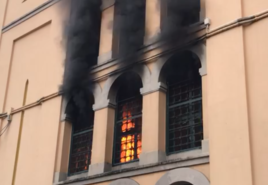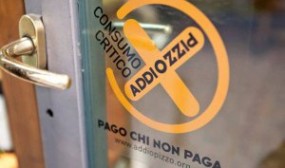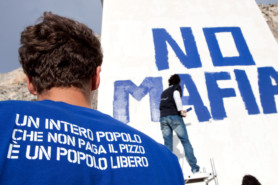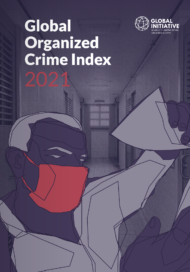Social media has become globally indispensable for many for purposes of instant communication, news consumption and a sense of connection. But these platforms, and the internet more broadly, are also valuable tools for criminals. In Italy, young mafia members use them to exert ‘soft’ power and promote their criminal culture.
According to the Global Organized Crime Index 2021, Italy ranks first among countries in Europe for the presence of mafia-style groups, with a score of 9: a criminal actor indicator that significantly hikes the country’s overall criminality score. As the birthplace of the original mafia, Italy is home to some of the world’s most powerful organized crime groups, operating domestically and abroad.
However, anti–organized crime efforts have been on the political agenda for decades, strengthening Italy’s institutional and non-state response to the point where it is among the most sophisticated globally. The findings of the Index show that Italy is one of only nine countries in the world that has simultaneously high levels of criminality and robust frameworks and mechanisms in place to counter organized crime.
Over the years, law enforcement authorities have succeeded in prosecuting criminals through investigations conducted on social media platforms. Consequently, after a wave of arrests in the early 2010s, mafia groups such as Sicily’s Cosa Nostra progressively abandoned online communications and reverted to analogue methods or in-person meetings. However, other Italian criminal groups have continued to wield their influence, aided by emerging tech.
The app paranze
The Neapolitan Camorra is a case in point. A criminal network comprising hundreds of small cells, over the years this southern-based mafia organization has experienced a generational replacement. In the early 2010s, law enforcement authorities arrested dozens of older-generation Camorra bosses. With many of the senior cohorts now behind bars (or murdered), a younger cadre has risen to the fore. These are known as the paranze (‘small fish’, or baby gangsters, in mafia slang).
Many paranze carry guns by their teenage years (some illicitly imported from Western Balkan countries, which are awash with firearms, or stolen from private security guards), which allows them to exercise violent control of the Neapolitan urban territories. In addition, as opposed to the steep hierarchical reporting lines adopted by Cosa Nostra and the ‘Ndrangheta, the Camorra is characterized by a more horizontal, autonomous structure that results in constant violent clashes between factions for territorial control, a war that is now fought by the paranze. Whereas, in the past, one could become a mafia boss only after reaching a certain seniority milestone, the free-for-all of armed violence has allowed Camorra teenagers to garner power at a precociously young age.
This generational replacement has caused a sea change in the Naples underworld: older bosses operated discreetly and observed omertà, the mafia’s long-honoured code of silence, but greener gang members have taken to flaunting their exploits on social media. With guns in one hand and their devices in the other, the Camorra screenagers have acquired a more substantial social media presence than any other mafia-style group in Italy. ‘The old-school boss would think twice before putting his face on the internet. Now, however, when the clan leader is a 20-year-old with a lifestyle based on showing off … he will have a strong social impact,’ said Camorra expert Sergio Nazzaro.
A subculture composed of online imagery of gang tattoos, status symbols and violence pervades Naples; it forms the symbology of belonging and membership among Camorra affiliates while appealing through its semiology to a wider potential audience of low-skilled youth of the region. Online posts reinforce positive values, such as respect for family members, friendship and loyalty, but within a criminal context. Such propaganda appears to be an indirect effect of the Camorra’s online presence – rather than an orchestrated effort to promote the group – but the organization ultimately benefits from the engagement indirectly, both in terms of social acceptance and building a prospective recruitment pool.
Targeted responses
Globalization and, with it, mass communication have enabled social networks to become the leading platforms for group and social identity building. Understanding how affiliates of criminal groups interact with their friends, followers and members of the same social and cultural subgroup allows for assessing how solid and widespread a criminal culture in a given area might be.
Anti-mafia judge Giovanni Falcone argued that responses should address organized crime culture rather than target criminals. In this vein, investigating how criminal groups exploit technology for purposes such as recruitment can prove valuable for law enforcement agencies. In addition, analyzing the nature of criminals’ online interactions can help identify recurrent patterns across cultures. The kinds of social media posts used by the paranze do not differ significantly from online activities of young members of Mexican drug cartels, Brazilian gangs such as the Comando Vermelho or the Bloods gang in California, to name a few. Comparative analysis could therefore be productive in the response.
Italy has a long history of innovative responses to organized crime, thanks to its powerful judiciary and civil society organizations. But to further strengthen the country’s resilience to organized crime, anti-mafia actors would benefit from intercepting online criminal activities. Content creators, social media experts and influencers are essential stakeholders in intervening in those virtual communities where organized crime groups build ties among followers. Monitoring social networks where organized crime affiliates promote their subculture would also mean shifting the scope of intervention from punitive to preventative and its nature from incriminatory to educational.
This analysis is part of the GI-TOC’s series of articles delving into the results of the Global Organized Crime Index 2021. The series explores the Index’s findings and their effects on policymaking, anti-organized crime measures and analyses from a thematic or regional perspective.
Ad oggi, i social media sono diventati quasi indispensabili a livello globale, per la comunicazione istantanea, il consumo di notizie e il senso di connessione e appartenenza. Ma queste piattaforme, e internet più in generale, si rivelano anche strumenti preziosi per le attività criminali. In Italia, i giovani membri della criminalità organizzata li usano per esercitare un soft power e promuovere una loro subcultura simil-criminale.
Secondo il Global Organized Crime Index (Indice globale della criminalità organizzata) 2021, l’Italia è al primo posto tra i Paesi europei per la presenza di gruppi mafiosi, con un punteggio di 9: un indicatore che innalza significativamente il punteggio complessivo di criminalità del Paese. In quanto luogo originario di nascita della mafia, l’Italia ospita alcuni dei gruppi di criminalità organizzata più potenti del mondo, operanti a livello locale, nazionale e internazionale.
Tuttavia, la lotta alla criminalità organizzata è stata inserita nell’agenda di governo per decenni, con effetti positivi sulla resilienza di non solo le istituzioni preposte alla lotta ma anche di enti privati e società civile. I risultati dell’Indice mostrano che l’Italia è uno dei soli nove Paesi al mondo che presenta contemporaneamente alti livelli di criminalità e solidi meccanismi di contrasto allo stesso tempo.
Nel corso degli anni, le forze di polizia sono riuscite a scovare e condannare membri di criminalità organizzata grazie ad indagini condotte sui social media. Di conseguenza, dopo un’ondata di arresti nei primi anni 2010, esponenti di gruppi come Cosa Nostra hanno progressivamente abbandonato le comunicazioni digitali e sono tornati a metodi analogici o a incontri di persona. Altri, invece, hanno continuato a esercitare la loro influenza aiutati dalle tecnologie emergenti.
Le app paranze
La Camorra ne è un esempio. Network criminale composto da decine di cellule, nel recente passato la Camorra è stata caratterizzata da un significativo ricambio generazionale. A partire dal 2010, le autorità cominciarono ad arrestare decine di boss della “vecchia guardia”, e con molti dei boss storici ora dietro le sbarre (o assassinati), i giovani e giovanissimi ricoprono oggi ruoli di comando: sono le cosiddette paranze.
Molti, in età ancora adolescenziale, sono armati fino ai denti con pistole e mitra facilmente accessibili nel mercato nero – molti arrivano dai Balcani – o rubati a guardie giurate. Con le armi, tengono sotto scacco interi quartieri di Napoli. Inoltre, in contrapposizione alle gerarchie ben definite che contraddistinguono altre mafie Italiane come Cosa Nostra e ‘Ndrangheta, la Camorra è caratterizzata da una struttura più orizzontale fatta di gruppi relativamente autonomi. Ciò si traduce in continui e violenti scontri tra fazioni per il controllo dello spaccio, una faida combattuta dalle paranze con aggressioni, ferimenti e omicidi. Se in passato si poteva diventare boss solo dopo aver raggiunto un certo “traguardo” di anzianità, oggi violenza armata e ferocia bastano per conquistare il potere, anche precocemente.
Questo ricambio generazionale ha provocato una svolta radicale nella malavita napoletana: i boss più anziani operavano in modo discreto e rispettavano l’omertà, le paranze invece impongono la loro violenza, e non si fanno problemi a sbandierare le loro imprese sui social media. Con la pistola in una mano e lo smartphone nell’altra, le paranze hanno affermato la loro presenza sui social media più di qualsiasi altro gruppo mafioso in Italia. “Il boss della vecchia scuola ci penserebbe due volte prima di mettere la sua faccia su Internet. Ora, invece, quando il capo clan è un ventenne con uno stile di vita basato sul mettersi in mostra… tutto ciò ha inevitabilmente un forte impatto sociale”, afferma l’esperto di Camorra Sergio Nazzaro.
Una subcultura composta da foto di tatuaggi, armi, orologi e musica neomelodica di sottofondo crea uno status symbol a cui si associare la violenza che pervade Napoli. È semplice “simbologia di appartenenza” tra gli affiliati della Camorra, e con un po’ di semiotica applicata a questo contesto si capisce come a questa subcultura si rifanno moltissimi giovani, a Napoli come in tutto il Mezzogiorno. Spesso, i post promuovono valori apparentemente positivi: il rispetto della famiglia, l’amicizia, la lealtà, tutti principi che all’interno di un contesto criminale cambiano completamente significato e assumono connotazione negativa.
In un certo senso, è come se la promozione di un certo stile vita “camorristico” agisse da vera e propria campagna di reclutamento di giovani leve nelle viuzze di Napoli e, se da un lato non lo si può provare, dall’altro rimane comunque un effetto desiderato per la Camorra: i clan ne beneficiano in termini di accettazione sociale e normalizzazione della presenza social.
Risposte mirate
La globalizzazione e, con essa, la comunicazione digitale di massa hanno permesso ai social network di diventare le principali piattaforme per la costruzione di gruppi e di identità sociali. Capire come gli affiliati ai gruppi criminali interagiscono con i loro amici, follower e membri dello stesso gruppo sociale e culturale permette di valutare quanto sia solida e diffusa la cultura criminale in una determinata area.
Giovanni Falcone sosteneva che la lotta al crimine organizzato non potesse prescindere dalla comprensione della cultura criminale. In questo senso, indagare su come i gruppi criminali sfruttino la tecnologia per scopi quali il reclutamento può rivelarsi prezioso per le forze dell’ordine. Inoltre, analizzare la natura e lo stile delle interazioni online di gruppi criminali può aiutare a identificare caratteristiche comuni a culture criminali geograficamente lontane fra loro. I contenuti social postati dalle paranze, infatti, non differiscono significativamente dalle attività online dei giovani membri dei cartelli della droga messicani, delle bande brasiliane come il Comando Vermelho o dai Bloods della California, per citarne alcune.
L’Italia ha una lunga storia di risposte innovative alla criminalità organizzata, grazie al suo imponente sistema giudiziario e al lavoro della società civile. Ma per rafforzare ulteriormente la resistenza del Paese alla criminalità organizzata, le istituzioni trarrebbero un sicuro vantaggio dall’intercettazione delle attività criminali online. I creatori di contenuti, gli esperti di social media, e gli influencer sono dunque stakeholders essenziali per andare a studiare e intervenire nelle comunità virtuali in cui i gruppi della criminalità organizzata si espongono e creano legami con i propri follower. In ultima analisi, monitorare e capire come nei social network gli affiliati promuovono la loro subcultura significa anche cambiare la natura dell’intervento pubblico di lotta alla criminalità da prettamente punitiva e incriminante a preventiva ed educativa.
Questa analisi fa parte della serie di articoli del GI-TOC che approfondiscono i risultati del Global Organized Crime Index 2021. La serie esplora i risultati dell’Indice e i loro effetti sulla definizione delle politiche, sulle misure contro la criminalità organizzata e sulle analisi da una prospettiva tematica o regionale.



